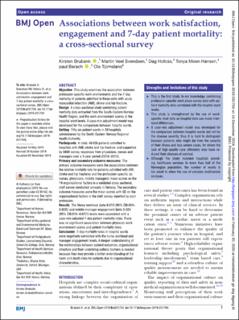| dc.description.abstract | OBJECTIVE:This study examines the association between profession-specific work environments and the 7-day mortality of patients admitted to these units with acute myocardial infarction (AMI), stroke and hip fracture. DESIGN:A cross-sectional study combining patient mortality data extracted from the South-Eastern Norway Health Region, and the work environment scores at the hospital ward levels. A case-mix adjustment model was developed for the comparison between hospital wards. SETTING:Fifty-six patient wards in 20 hospitals administered by the South-Eastern Norway Regional Health Authority. PARTICIPANTS:In total, 46 026 patients admitted to hospitals with AMI, stroke and hip fracture, and supported by 8800 survey responses from physicians, nurses and managers over a 3-year period (2010-2012). PRIMARY AND SECONDARY OUTCOME MEASURES:The primary outcome measures were the associations between the relative mortality rate for patients admitted with AMI, stroke and hip fractures and the profession-specific (ie, nurses, physicians, middle managers) mean scores on the 19 organisational factors in a validated cross sectional, staff survey conducted annually in Norway. The secondary outcome measures were the mean scores with SD on the organisational factors in the staff survey reported by each profession. RESULTS:The Nurse workload (beta 0.019 (95% CI0.009-0.028)) and middle manager engagement (beta 0.024 (95% CI0.010-0.037)) levels were associated with a case-mix adjusted 7-day patient mortality rates. There was no significant association between physician work environment scores and patient mortality rates. CONCLUSION:7-day mortality rates in hospital wards were negatively correlated with the nurse workload and manager engagement levels. A deeper understanding of the relationships between patient outcomes, organisational structure and their underlying cultural barriers is needed because they may provide a better understanding of the harm and death risks for patients due to organisational characteristics. | |
